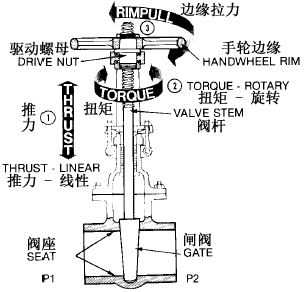决定阀门操作的力主要有三种:推力,扭矩和边缘拉力。下面简要介绍确定某个阀门三种力所用到的公式。参阅第3页至第7页,了解与测定美国太平洋闸阀、截止阀和截止止回阀的推力、扭矩和边缘拉力相关的参考数据。这些内容也包括碳钢阀门在最大或一半的冷工作压力下压差的扭矩。
The three major forces involved in valve actuation
are thrust, torque and rimpull. Below is a brief description and formula
used to determine each of the three forces for a particular valve application.
See pages 3 through 7 for
reference data to be used with Pacific gate, globe and stop-check valves
to determine thrust, torque and rimpull for a particular application.
These pages also show torque for differential pressures at full and half
maximum cold working pressure for carbon steel valves.
推力是阀门在开启和关闭时阀座上产生的纯粹线性推力或拉力。推力可以按照下列阀门和应用条件进行测定:
Thrust is the purely linear push-pull force involved
in seating and unseating a valve. It is determined using the following
valve and application criteria:
- – 阀门阀座直径。
如果不知道阀门阀座的直径,则可以将端口直径作为阀座直径进行估算。
– The valve seat diameter.
If the valve seat diameter is not known, the port diameter can be assumed
to be the seat diameter for estimating purposes.
- – 通过阀门阀座的最大压差。
测定阀门阀座的最大压差的最常用方法是将最大设计或工作压力作为上游的压力值P1,然后假定下游压力值P2为0 PSIG.
– The maximum differential pressure across the
valve seat.
The most common method of determining maximum differential pressure
across the valve seats is to assign the maximum design or operating
pressure the upstream value P1 and assume a downstream pressure P2 of
0 PSIG.
- – 阀门阀杆直径。
–The valve stem diameter.
这些用来计算推力的因素是下列力的合力。推力的计算单位是磅。
These criteria are used in the thrust calculation
which is the sum of the following forces. Unit of measure is Ibs. of thrust.
| 1. |
| 阀座力 = |
阀门阀座面积 x 最大压差 x 阀门系数 |
| Seating Force = |
Valve seat area x Max differential
Pressure x Valve factor |
| 最大压差 = |
P1- P2 |
| Max. differential
Pressure = |
P1- P2 |
| 阀门系数 = |
0.25 平行阀座
0.3 闸阀
1.1 截止阀 |
| Valve
factor = |
0.25 Parallel seat
0.3 Gate valve
1.1 Globe valve |
|
| 2. |
| 阀杆负载 = |
阀杆面积 x 最大上游压力 |
| Stem Load = |
Valve stem area x Max. upstream pressure |
| 在此:阀杆面积 = |
|
| Where: Valve
stem area = |
|
| 最大上游压力 = |
P1 |
| Max upstream
Pressure = |
P1 |
注意,阀杆负载只适用于闸阀,因为截止阀和截止止回阀的阀座力包含了阀杆负载。
Note that stem load is applicable to gate
valves only as this force is included in the seating force of globe
and stop-check valves. |
| 3. |
阀杆填料摩擦力 = 阀杆直径 x 2000 适用于石墨。
Stem Packing Friction = Stem diameter x 2000
for graphite. |
* 例子:DN150, 150磅闸阀,阀座直径6英寸, 阀杆直径为11/8英寸,最大压差为100
PSIG.
* Example - 6" 150 Ib. gate valve, seat diameter
6", stem diameter 11/8", maximum differential
pressure 100 PSIG.
| 1. |
阀座力 = 28.26 x 100 x .3 = 847.8 磅
Seating force = 28.26 x 100 x .3 = 847.8
lbs. |
| 在此:阀座面积 = |
|
| Where: Seat
area = |
|
|
| 2. |
阀杆负载 = .994 x 100 = 99.4磅
Stem load = .994 x 100 = 99.4 lbs. |
| 在此:阀杆面积 = |
|
| Where Stem
area = |
|
|
| 3. |
阀杆填料摩擦力 = 1.125 x 1000 = 1125
启闭阀门时阀座上的推力 = 847.8 + 99.4 + 1125 = 2072.2 磅
Stem packing friction = 1.125 x 1000 = 1125
Thrust to seat or unseat = 847.8 + 99.4 + 1125 = 2072.2 Ibs.
|
阀门运行推力只是阀门阀杆行程力的90%,因此测算阀门推力时,要加上阀杆负载和阀杆填料摩擦力。
Valve running thrust which represents 90% of the
travel of the valve stem can be determined by adding stem load and stem
packing friction. |
|

扭矩是一种旋转力。使用中的闸阀和截止阀配置由驱动螺母驱动的梯形螺纹升降阀杆,此时,推力就由纯粹的线性力转换成扭矩,利用螺纹的机械性能来实现线性运动。用来将推力转换成扭矩的阀杆系数是阀杆和驱动螺母(轭架套管)上的梯形螺纹的函数。第3页至第7页包括美国太平洋闸阀、截止阀和截止止回阀的阀杆系数。一旦计算出启闭阀门时的阀座推力,则扭矩也可以从下列公式得到:
Torque is a rotary force. For gate and globe valve
applications which have acme threaded rising stems driven by a drive nut,
torque is conversion of thrust from a purely linear force, utilizing the
mechanical advantage of a screw to achieve linear movement. The stem factor
used to convert thrust to torque is a function of the acme thread characteristics
of the valve stem and drive nut (yokesleeve). Pages AA-3
thru AA-7 contain stem factors for Pacific gate,
globe and stop-check valves. Once seating or unseating thrust has been
calculated, the torque can be obtained by the formula:
扭矩 = 推力 x 阀杆系数
Torque = Thrust x Stem factor
*例子:DN150, 150磅闸阀
推力 = 2072.2
阀杆系数 = 0。0099
扭矩 = 2072.2 x 0.0099 = 20.5英尺·磅
*Example: 6" 150 Ib. Gate valve
Thrust = 2072.2
Stem factor = .0099
Torque = 2072.2 x .0099 = 20.5 ft. Ibs.
利用上列公式,用阀座推力替代运行推力,就可以计算出阀门的运行扭矩。
Valve running torque can be calculated utilizing
the above formula substituting running thrust for seating thrust.
边缘拉力是指在操作阀门时必须施加在手轮边缘的力。边缘拉力是利用扭矩来计算的。在计算手轮边缘拉力时,需要下列资料:
Rimpull is the force which must be applied to
the rim of the handwheel during operation of the valve. Rimpull is calculated
using torque. The following information is required to calculate handwheel
rimpull:
| A. |
启闭阀门所需的扭矩
Torque required to seat or unseat valve |
|
| B. |
| 边缘拉力 = |
扭矩 ÷ 手轮半径(以英尺为单位) |
| Rimpull = |
Torque ÷ Radius of the handwheel
measured in feet |
| 在此:手轮半径 = |
|
| Where: The
radius of the handwheel = |
| Handwheel Dia. in inches |
|
| 2 |
|
| 半径(换算成英尺) = |
|
| The radius
is converted to feet = |
|
|
| |
*例子:DN150, 150磅闸阀
启闭阀门的扭矩 = 20.5英尺·磅
手轮直径 = 14英寸
边缘拉力 = 20.5 ÷ 0.583 = 35.2 磅
*Example: 6"150 Ib. Gate
Seating or unseating torque = 20.5 ft. Ibs.
Handwheel diameter = 14"
Rimpull = 20.5 ÷ .583 = 35.2 lbs. |
| |
| Where: |
|
= 7 = (Radius in inches) |
| |
|
0.583 (Radius in feet)
= 35.2 Ibs. |
用运行扭矩替代启闭阀门的阀座扭矩,可以计算出运行边缘拉力。
Running rimpull can be calculated by substituting
running for seating/unseating torque. |
|